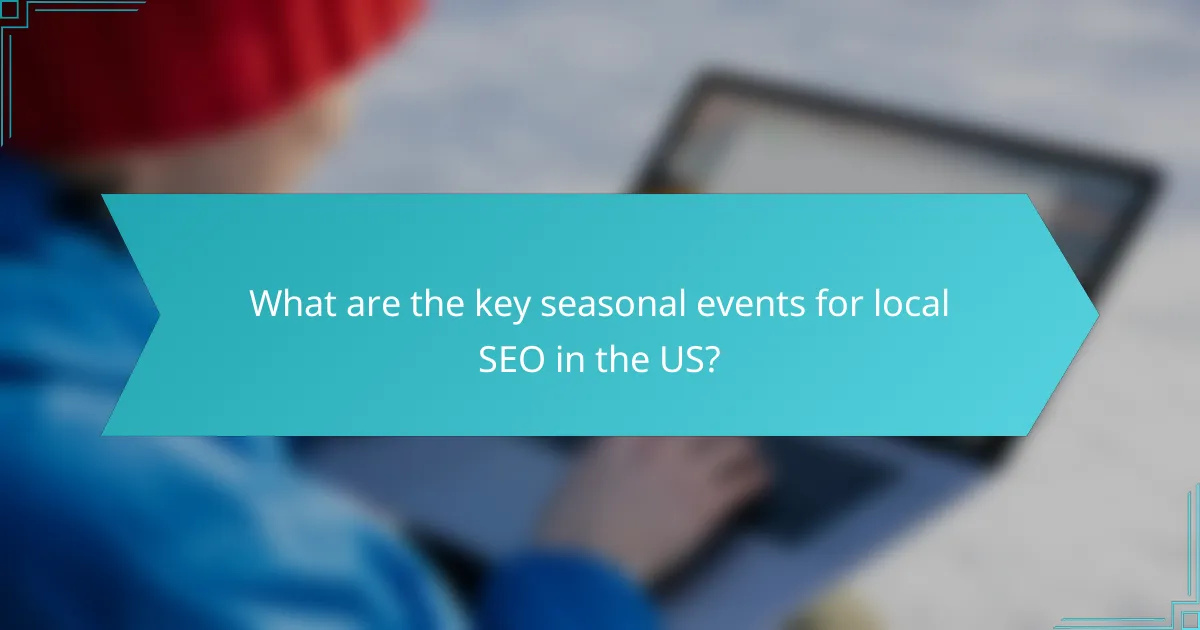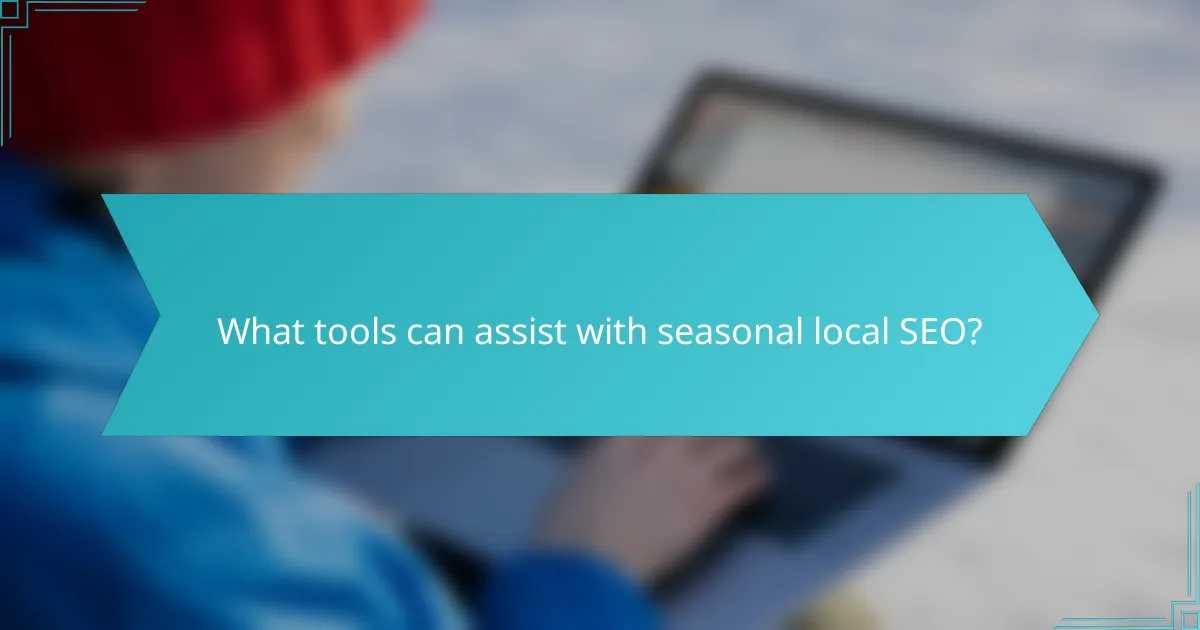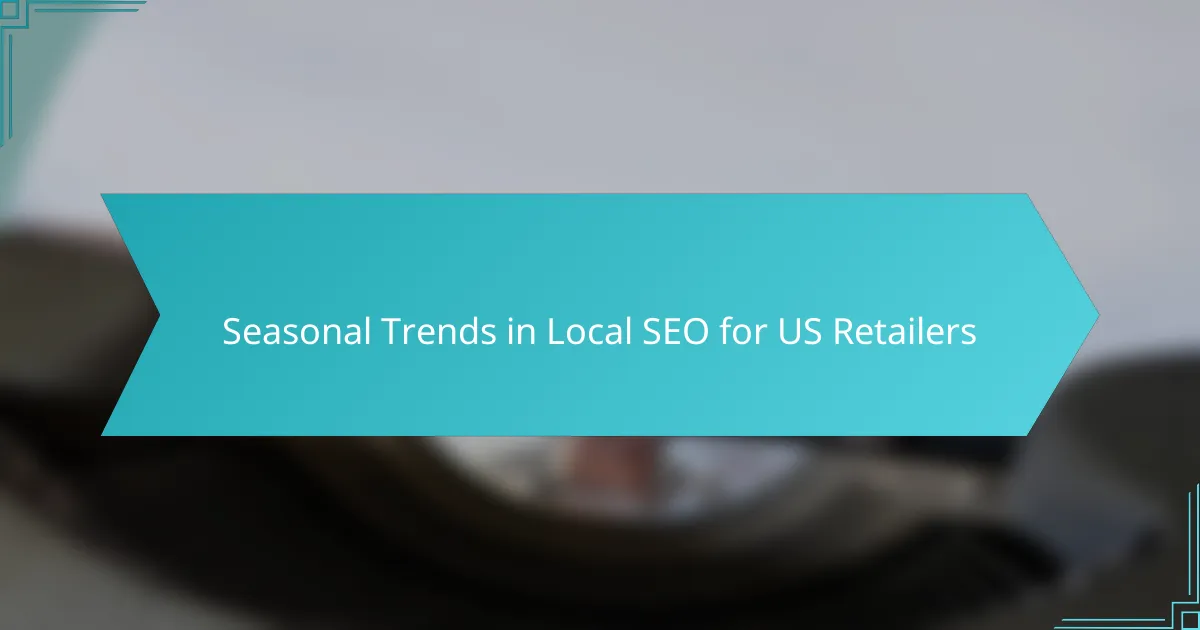Seasonal trends play a crucial role in shaping local SEO strategies for US retailers, as they directly impact consumer search behaviors and demand. By optimizing their online presence and tailoring content to align with these trends, retailers can enhance visibility and engagement during peak shopping periods. Analyzing performance metrics allows retailers to refine their approaches, ensuring they attract more customers when it matters most.

How do seasonal trends affect local SEO for US retailers?
Seasonal trends significantly influence local SEO for US retailers by altering search behaviors and demand patterns. Retailers must adapt their strategies to leverage increased visibility and engagement during peak seasons.
Increased search volume during holidays
During holidays, search volume for local retailers typically surges as consumers seek gifts and seasonal products. For instance, searches for “Christmas gifts near me” or “Thanksgiving dinner supplies” spike in the weeks leading up to these events.
Retailers should optimize their local SEO strategies by updating keywords and ensuring their Google My Business listings are current. This includes adding holiday-specific promotions and adjusting operating hours to accommodate increased foot traffic.
Changes in consumer behavior
Seasonal trends can shift consumer behavior, leading to a preference for local shopping. Many consumers prioritize convenience and support for local businesses during holidays, which can enhance foot traffic and online orders.
Retailers should focus on creating localized content that resonates with seasonal themes. For example, blog posts about holiday shopping tips or community events can engage local customers and improve search rankings.
Impact on local search rankings
Local search rankings can fluctuate during peak seasons due to increased competition and search activity. Retailers that optimize for seasonal keywords may see improved visibility in local search results, while those that do not may fall behind.
To maintain or improve rankings, retailers should regularly update their SEO strategies, including optimizing their website for mobile users and ensuring that their NAP (Name, Address, Phone number) information is consistent across platforms. Engaging with customer reviews and local backlinks can also enhance credibility and visibility during busy seasons.

What strategies can US retailers implement for seasonal SEO?
US retailers can enhance their seasonal SEO by focusing on local search visibility, optimizing online presence, and tailoring content to reflect seasonal trends. Implementing targeted strategies can significantly improve search rankings and attract more customers during peak shopping periods.
Optimize Google My Business listings
Optimizing Google My Business (GMB) listings is crucial for seasonal SEO. Ensure that your business information is accurate, including hours of operation, address, and contact details, especially during holidays when hours may change. Regularly update your GMB profile with seasonal promotions and high-quality images to engage potential customers.
Encourage satisfied customers to leave positive reviews, as these can enhance your visibility in local search results. Responding to reviews promptly also demonstrates good customer service, which can influence new customers’ decisions.
Create seasonal landing pages
Creating seasonal landing pages allows retailers to target specific products or promotions relevant to the season. These pages should include keywords related to the season, such as “back-to-school sales” or “holiday gift ideas,” to attract search traffic. Ensure that the content is fresh and tailored to the current season to improve user engagement.
Consider including special offers, featured products, and relevant blog posts on these landing pages. This not only enhances SEO but also provides a better user experience, encouraging visitors to explore more of your site.
Leverage local keywords
Leveraging local keywords is essential for effective seasonal SEO. Research and incorporate keywords that reflect local trends and seasonal events, such as “summer sales in [City]” or “fall fashion in [State].” Tools like Google Keyword Planner can help identify popular local search terms.
Integrate these keywords naturally into your website content, including product descriptions, blog posts, and meta tags. This strategy helps improve your visibility in local search results, driving more traffic to your site during peak seasons.

How can US retailers analyze seasonal SEO performance?
US retailers can analyze seasonal SEO performance by leveraging various tools and metrics that provide insights into website traffic, keyword effectiveness, and conversion rates. Understanding these elements helps retailers adjust their strategies to optimize visibility and sales during peak seasons.
Use Google Analytics for traffic insights
Google Analytics is a powerful tool for US retailers to track website traffic patterns throughout the year. By examining metrics such as sessions, page views, and user demographics, retailers can identify seasonal trends and spikes in traffic related to specific holidays or events.
To effectively utilize Google Analytics, set up custom reports that focus on seasonal periods. For instance, compare traffic data from the holiday season to other months to gauge performance. Look for trends in user behavior, such as increased mobile traffic during certain times, which may indicate a need for mobile optimization.
Monitor keyword rankings
Monitoring keyword rankings is essential for understanding how seasonal changes affect search visibility. Retailers should track keywords that are relevant to their products and services, especially those that peak during specific seasons, like “summer sale” or “holiday gifts.”
Utilize tools like Google Search Console or third-party SEO software to monitor keyword performance. Regularly check for fluctuations in rankings and adjust content strategies accordingly. For example, if a keyword sees a drop in ranking during a peak season, consider optimizing the associated content or increasing backlinks to regain visibility.
Evaluate conversion rates
Evaluating conversion rates helps retailers determine the effectiveness of their seasonal SEO efforts. By analyzing the percentage of visitors who complete a purchase, retailers can assess whether seasonal campaigns are driving sales.
To evaluate conversion rates, segment data by season and compare it to previous periods. Look for patterns that indicate successful strategies, such as promotional offers or targeted content. If conversion rates are lower than expected during a peak season, investigate potential issues, such as website performance or user experience, that may hinder sales.

What are the key seasonal events for local SEO in the US?
Key seasonal events for local SEO in the US include major shopping days and periods that significantly influence consumer behavior. Understanding these events allows retailers to optimize their online presence and attract more local customers during peak shopping times.
Black Friday and Cyber Monday
Black Friday and Cyber Monday are pivotal shopping days that mark the beginning of the holiday shopping season in the US. Retailers often see a surge in online and in-store traffic, making it essential to optimize local SEO strategies to capture this increased interest.
To effectively leverage these events, retailers should focus on local keywords, create targeted promotions, and ensure their Google My Business listings are up-to-date. Engaging content that highlights special offers can also drive foot traffic and online sales.
Back to School season
The Back to School season is a significant shopping period for families preparing for the new academic year. This time typically spans from late July to early September, with retailers offering discounts on school supplies, clothing, and electronics.
For local SEO, businesses should optimize their listings with relevant keywords like “school supplies near me” and create content that addresses local school schedules and needs. Promotions tailored to families can enhance visibility and attract more customers during this busy season.
Holiday shopping trends
Holiday shopping trends encompass various festivities, including Christmas and New Year’s, where consumer spending peaks. This period often begins in late November and extends through December, with shoppers looking for gifts, decorations, and holiday-related services.
Retailers should optimize their local SEO by incorporating holiday-specific keywords and creating engaging content that resonates with seasonal themes. Offering local delivery options and highlighting in-store events can further enhance customer engagement and drive sales during this critical shopping season.

What tools can assist with seasonal local SEO?
Several tools can significantly enhance seasonal local SEO efforts for US retailers by providing insights into keyword performance, backlink quality, and seasonal trends. Utilizing these tools effectively can help businesses optimize their online presence and capture more local traffic during peak seasons.
SEMrush for keyword research
SEMrush is a powerful tool for conducting keyword research, particularly for identifying seasonal keywords that can drive traffic. Retailers can analyze search volume trends over time, allowing them to target specific keywords that peak during certain seasons.
To maximize its effectiveness, retailers should focus on long-tail keywords that reflect seasonal buying behavior, such as “summer sale shoes” or “holiday gift ideas.” Regularly updating keyword lists based on seasonal trends can help maintain relevance and visibility in search results.
Ahrefs for backlink analysis
Ahrefs excels in backlink analysis, which is crucial for improving local SEO rankings. By examining the backlink profiles of competitors, retailers can identify potential link-building opportunities that align with seasonal campaigns.
Retailers should prioritize acquiring backlinks from local sources, such as community blogs or local news sites, especially during peak seasons. This can enhance their authority and visibility in local search results, driving more traffic to their websites.
Google Trends for seasonal insights
Google Trends is an invaluable resource for gaining insights into seasonal search behavior. Retailers can explore how interest in specific products or services fluctuates throughout the year, helping them tailor their marketing strategies accordingly.
By analyzing search trends, retailers can identify peak times for promotions and adjust their inventory and marketing efforts. For instance, if a spike in searches for “fall clothing” is detected in late summer, retailers can prepare their campaigns in advance to capitalize on this trend.

How do competitors adapt to seasonal trends in local SEO?
Competitors adapt to seasonal trends in local SEO by adjusting their strategies to align with consumer behavior during different times of the year. This includes optimizing their online presence, leveraging local keywords, and enhancing customer engagement through targeted promotions and content.
Seasonal promotions and discounts
Seasonal promotions and discounts are critical for retailers looking to attract local customers during peak shopping periods. For instance, offering holiday sales or back-to-school discounts can significantly boost foot traffic and online engagement. Retailers should consider using geo-targeted ads to promote these offers, ensuring they reach the right audience at the right time.
Additionally, incorporating urgency in promotions, such as limited-time offers, can encourage quicker purchasing decisions. Retailers might also want to analyze past seasonal sales data to determine the most effective discounts and timing for their target market.
Content marketing strategies
Content marketing strategies should be tailored to reflect seasonal themes and local interests. Creating blog posts, social media content, and email newsletters that highlight seasonal products or events can enhance visibility and engagement. For example, a local bakery might share recipes or tips for holiday baking, attracting customers looking for seasonal inspiration.
Moreover, utilizing local SEO best practices, such as incorporating relevant local keywords and optimizing Google My Business listings, can help content reach a wider audience. Retailers should also consider user-generated content, like customer reviews and photos, to build community and trust during seasonal campaigns.
